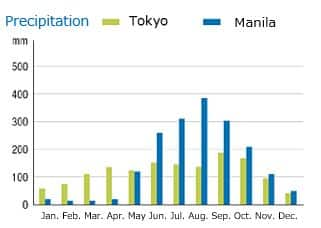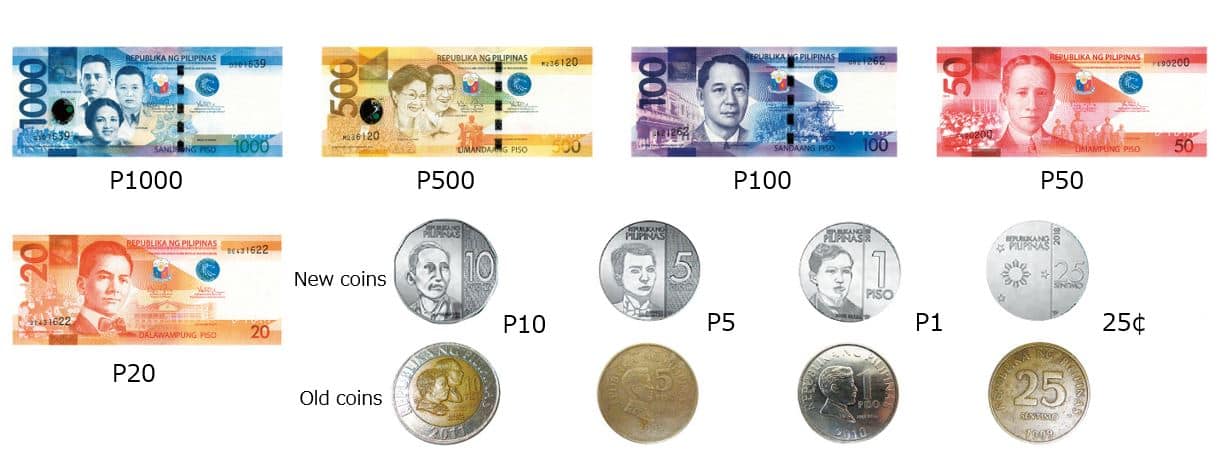Please select the card you wish to join

Get your digital card immediately
No enrollment or annual fees
ANA Mileage Club Card

Earn more miles for your money
With credit function
ANA Card
-
Reservations
-
MILES
-
MILES
-
Login
-
Support
Manila
on February 29ty, 2024 (JST) current information.
Furthermore, the details under "Visa", "Passport" and "Vaccination" are for Japanese nationals.
This information is likely to change suddenly, so please contact the relevant official authority (e.g., embassy) for the latest information.
Immigration and Visa
Visa
A visa is not required for stays for tourism or business purposes up to 30 days counting from the day of arrival. If staying for 31 days or more, tourist visas valid for 59 days are available from a Philippine Consulate or the Philippine Embassy in Japan. You can also complete procedures to extend your stay in the Philippines, up to 29 days the first time (for a total of 59 days), but even in this case, when you enter the country, you need to show an airline ticket for departure within 30 days. Since April 15, 2023, it has been necessary for all persons entering the Philippines, including infants, to register on the eTravel system from 72 hours before your flight time and before immigration inspection
eTravel registration webpage
Passport
You can enter the country if you have a Japanese passport valid during your entire stay and can show an airline ticket for departure to a third country. However, there has been confusion because this allowance is limited to the passport holders of certain countries including Japan, and entry has been denied because the remaining period of validity of those travellers' passports has been less than 6 months, so the Japanese Ministry of Foreign Affairs recommends that travellers ensure their passports have a remaining period of validity of at least 6 months in addition to their planned period of stay.
Quarantine
When traveling from Japan to the Philippines, you must inquire and check with the following departments in advance about bringing in animals, plants, fisheries products or processed items made from those item.
- 1. Plants and processed plant products
Plant Protection Station
Bureau of Plant Industry - 2. Animals and fisheries products and processed products made from themAnimal Quarantine Service
Bureau of Animal Industry
Customs
Bringing in e-cigarettes
As of January 2022, bringing in heated tobacco products (tobacco leaf type) is allowed, but vapes (e-cigarettes, liquid type) are prohibited.
Vaccination
Not required when departing from Japan.
For bringing and possession of tax-free cigarettes
Visitors may bring up to 2 bottles of liquor (but not exceeding 1liters for each), up to either 400 cigarettes, 50 cigars, or 250g of loose tobacco, and may bring in and take out up to P50,000 in Philippine pesos. Foreign currency amounts of US$10,000 or more must be declared.
Time difference and Daylight Saving Time
Time difference
The Philippines is 1 hour behind Japan. When it is 12:00 in Japan, it is 11:00 in the Philippines. Daylight saving time is not observed in the Philippines.
Climate
Climate
The Philippines has a tropical climate that is warm throughout the year with an average yearly temperature of 26°C to 27°C. The seasons are divided into the rainy season from June to November, and the dry season from December to May, but there is a significant difference depending on region. Clothing worn in summer in Japan is suitable for wearing in the Philippines throughout the year. However, some places have the air conditioning turned up in airplanes, overnight buses, hotels, department stores, etc., so it is best to have a jacket to cover up with. The sunlight is strong, so bringing sunglasses and a hat is convenient.

The average temperature in Manila and Tokyo

Precipitation in Manila and Tokyo
-
Monthly average temperature and precipitation
The average temperature in Tokyo and Manila
month The average temperature in Tokyo The average temperature in Manila Jan. 6℃ 26℃ Feb. 6℃ 27℃ Mar. 9℃ 28℃ Apr. 15℃ 30℃ May 18℃ 29℃ Jun. 22℃ 28℃ Jul. 25℃ 28℃ Aug. 27℃ 27℃ Sep. 23℃ 28℃ Oct. 17℃ 27℃ Nov. 14℃ 26℃ Dec. 8℃ 25℃ The average precipitation in Tokyo and Manila
month The average precipitation in Tokyo The average precipitation in Manila Jan. 60mm 20mm Feb. 80mm 10mm Mar. 110mm 10mm Apr. 130mm 20mm May 120mm 110mm Jun. 140mm 260mm Jul. 130mm 310mm Aug. 120mm 390mm Sep. 190mm 300mm Oct. 170mm 200mm Nov. 90mm 100mm Dec. 40mm 50mm
Currency and Exchange Rate, Tax, Currency exchange, Tip
Currency and Exchange Rate

New coins are in circulation as of the end of 2017. The validity end date of the old coins has not been decided, and so they are currently still in use.
The unit of currency is the Philippine peso (P), which is subdivided into centavos (¢). P1 is 100¢. As of March 18, 2024, P1 is approx. JPY2.68.
There are eight denominations of banknotes: P1000, P500, P200, P100, P50, P20, P10, and P5 (P200 is not often seen). There are eight types of coins: P20, P10, P5, P1, 20¢, 10¢, 5¢, and 1¢ (the 1¢ is not often seen).
Currency Exchange
US dollars and Japanese yen can be changed into Philippine peso at hotels, city banks, moneychangers, and banks in airports. Moneychangers offer the best exchange rates, and hotels the worst. Sometimes, banks will not accept Japanese yen in exchange. Keep the receipt for currency exchange until the last day of your trip as sometimes it must be shown when re-changing money. In addition, often change is not available in Japanese yen at banks and moneychangers, so bringing plenty of 1000-yen bills from Japan cuts down on excessive currency exchange. Furthermore, when traveling to rural areas, it is safer to exchange Japanese yen for pesos in Manila, Cebu City, etc.
Tip
Porters at the airport and hotels should be tipped P20 to P50 per piece of luggage, and when restaurant bills do not include a service charge or taxi, usually a tip of approx. 10% of the meal charge is left. Outside the major cities and resort areas, there is no custom of tipping in provincial cities and country towns, etc.
Voltage and plug
Voltage

Type A, Type B3, Type C
220V, 60Hz. The shape of the plug is mostly the same as that in Japan (type A), but type B3, C, or O is used in some parts of the country. A transformer is needed for using electrical devices that are not compatible with 100 to 240V.
Video and DVD
Video and DVD
The Philippines uses the same NTSC video system as Japan, so normal video players used in Japan can play DVD and other media from the Philippines. The DVD region code for the Philippines is 3, while it is 2 for Japan. However, if a DVD displays region code 2, it can be played on a computer equipped with a DVD player.
Airmail to Japan costs P50 for a sealed letter up to 20g and P15 for a postcard. Mail is delivered to Japan in 5 to 10 days.
Phone Call
How to phone
Telephoning Japan from Philippines
Telephoning Japan from Philippines
When calling Tokyo (03) 1234-5678
dial 00 (International telephone identification number)
81 (Country Code, Japan)
3 (Remove the first 0 for area codes and mobile telephone numbers)
1234-5678(Other parties telephone number)
Telephoning Philippines from Japan
Telephoning Philippines from Japan
When calling Philippine Manila (02) 2345-6789
International Telephone Company No.
- The following apply if calling from a fixed-line phone. They do not apply if calling from a mobile phone or a FLET's VoIP phone.
- 0033 (NTT Communications)
- 0061 (SoftBank)
010 (International Identification No.)
63 (Country Code, Philippines)
2 (Remove the first 0 for area codes)
2345-56789 (Other parties telephone number)
Holiday / National holiday
Holiday / National holiday
There are many holidays related to Christianity. Note that holidays fall on different dates, depending on the year. On national holidays, shops, banks, post offices, etc. are closed. There are also special holidays.
2024
- January 1: New Year’s Day
- February 9 to 10: Chinese New Year*1
- March 28 to 30: Easter holiday*1
- April 9: Day of Brave
- May 1: May Day
- June 12: Independence Day
- August 21: Ninoy Aquino Day
- August 26: National Heroes Day*1
- November 1: All Saints Day
- November 30: Bonifacio Day
- December 8: Immaculate Conception
- December 25: Christmas
- December 30: Rizal Day
- December 31: New Year's Eve
- *1.holidays fall on different dates, depending on the year.
Language
Language
The official language is Tagalog. However, depending on the region, languages other than Tagalog is used, such as Visayan in the Visayan Islands. In parts of the Cavite province outside of Manila and parts of the Mindanao Island, the Chavacano language is also spoken, which includes a lot of Spanish. English is the common language and is the most understood language in Asia. There are around 80 other languages in the Philippines, including Llocano and Waray.
Business hours, etc
Business hours
Banks
Generally open from Mon. to Fri. 9:00 to 15:00, closed on Sat., Sun., holidays.
Shops
Supermarkets, shopping centers, etc. are open every day around 10:00 to 21:00; some small stores are open until around 21:00. Many shopping centers are open longer than usual on weekends.
Restaurants
Open early morning to around 24:00, depending on the establishment. In large cities such as Manila, Cebu City, and Davao, many are open 24 hours.
Most stores are closed and transportation services do not operate during the Easter Holiday (In 2023 April 6 to 9 (4 days). Varies by year).
Age Limit
Age restrictions on rental cars differs depending on the rental company, but in the Philippines, driving is so rough as to be incomparable to driving in Japan, so it is better not to drive even if you have a driver’s license.












